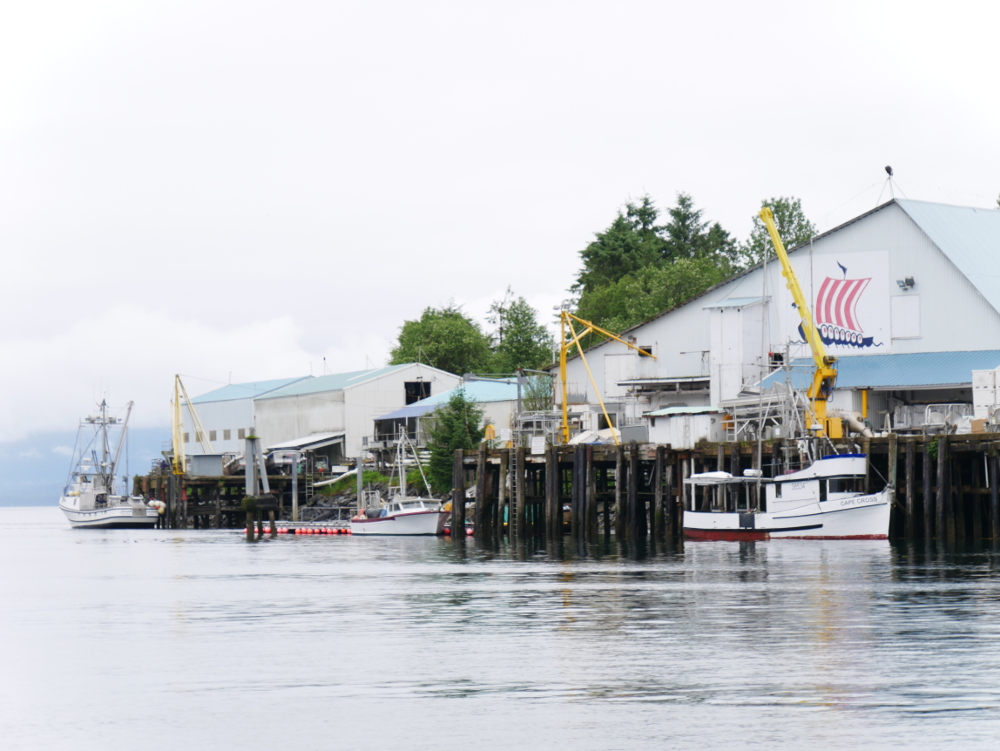
Fishing boats tied up to the Icicle Seafoods Petersburg Fisheries plant in June of 2018. (Joe Viechnicki/KFSK)
2019 could be another down year for pink salmon fishing in Southeast Alaska. The Alaska Department of Fish and Game and scientists with NOAA Fisheries Auke Bay Lab are forecasting a commercial harvest of 18 million fish, which would fall in the weak category for catches over the past six decades.
“You know we’ve seen low even year harvests but this would be the lowest odd-year harvest we’ve seen in quite a while if this materializes,” said Andy Piston, Fish and Game’s pink and chum salmon project leader for Southeast.
18 million would be about half of the recent 10-year average and the lowest odd-year harvest in over 30 years. It would be well down from the catch in 2017, when fishing fleets netted 34 million pinks in the region. That was the year when the parents of the 2019’s salmon were spawning. And Piston notes that escapement levels, or numbers of fishing making it back to spawning streams that year, were generally good.
“Yes it definitely appears like fresh water and early marine survival was low and you base that just on the fact we know escapements were quite good throughout almost the entire region,” Piston said. “But now we’re seeing very few juvenile salmon leaving inside waters.”
The forecast is based the Southeast Coastal Monitoring Project, which studies juvenile salmon. NOAA Fisheries scientists perform an annual trawl survey of out-migrating pink salmon leaving streams in the northern part of the region. Scientists also study the numbers of fish returning to spawn and the corresponding numbers of young salmon that leave Auke Creek in Juneau the following year.
In the past, the state and federal agencies have produced separate forecasts of the pink salmon catch. This year they’re teaming up to produce one forecast. And Piston said that’s because of the success of the annual trawl survey. “And that piece of information has really been the most useful forecasting information for pink salmon we’ve ever had,” he said. “And so the ADF&G forecast over recent years we’ve done a slightly different method but it was primarily because we didn’t want to take NOAA’s data and do the exact same thing with it but what we’re joining forces and doing now is the forecast that makes the most sense to do. So that’s how we plan on proceeding in the future is just make more of a joint effort, both the survey and the forecast.”
This year’s data from that trawl survey showed the third lowest abundance of pinks leaving streams in 22 years of that research. The size of the out-migrating pinks was unusual this year too. Juvenile pinks caught in the NOAA survey this year were the shortest recorded in the 22 years of the survey.
Pink salmon are caught mainly by the region’s purse seine fleet and often canned or frozen for processing overseas. This year’s catch of just over eight million was the lowest since 1976. It was also just the second time in history that the region’s catch of pink salmon was surpassed by the number of chum salmon.
Scientists also caution about the return of warm water in the Pacific Ocean, known as The Blob. Past warm ocean temperatures have coincided with low returns of pinks and that could be a factor in the fish returning in 2019.
Piston plans to report on the pink salmon forecast during the meeting of a task force comprised of fishery managers and purse seine industry representatives Wednesday, November 28 from 9a.m. – 5 p.m. in borough assembly chambers in Petersburg.
A drift gillnet task force is scheduled for Tuesday, November 27 from 9 a.m. to 5 p.m. in the same place. And a Southeast Regional Planning team will meet on hatchery decisions on Thursday, November 29 from 9 a.m. to 5 p.m. also in Petersburg borough assembly chambers.









